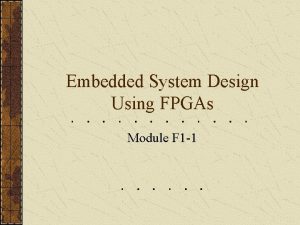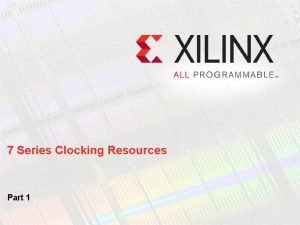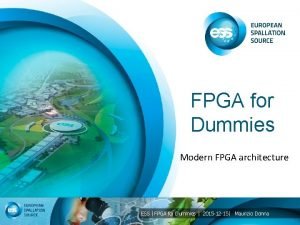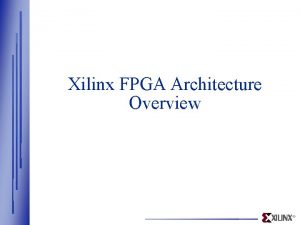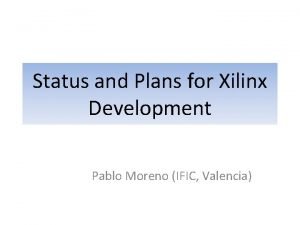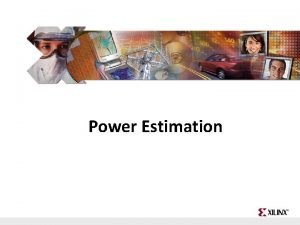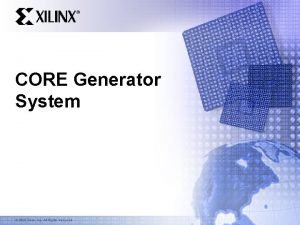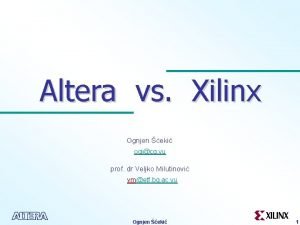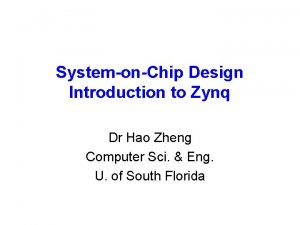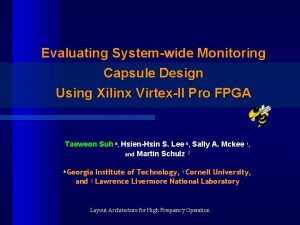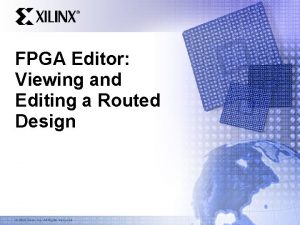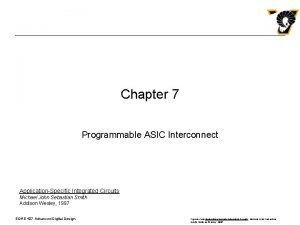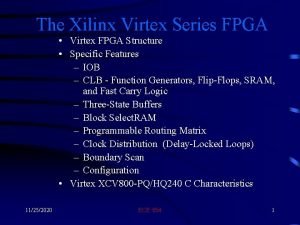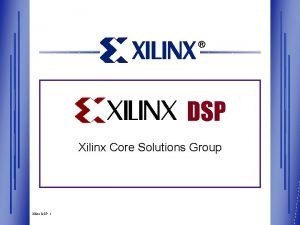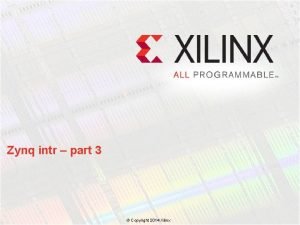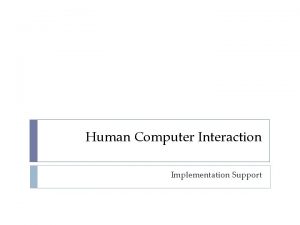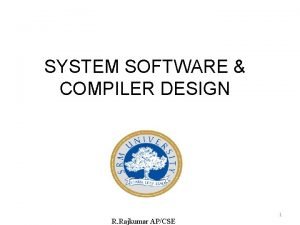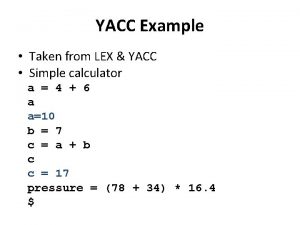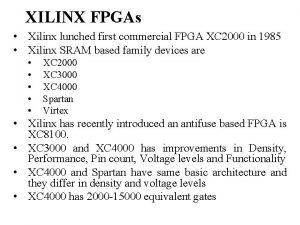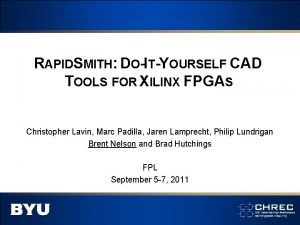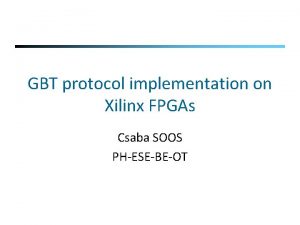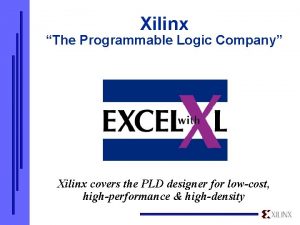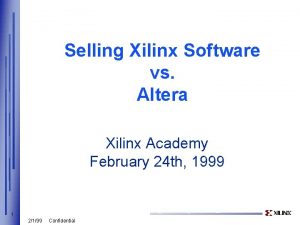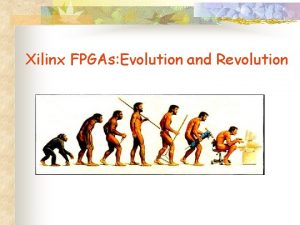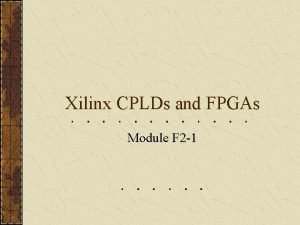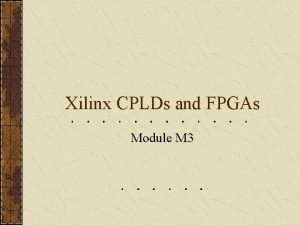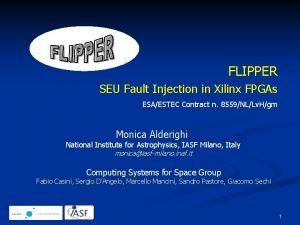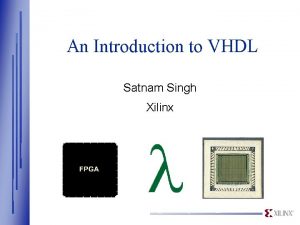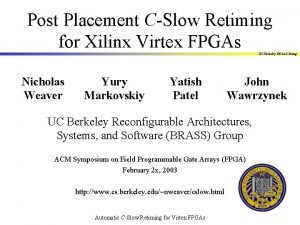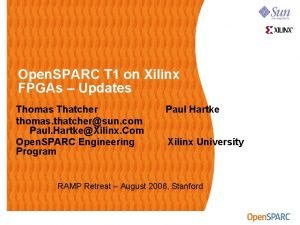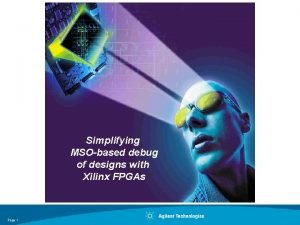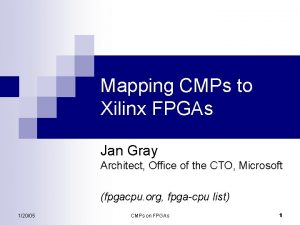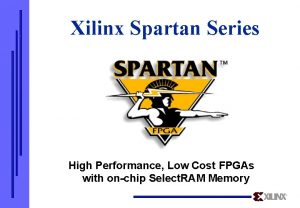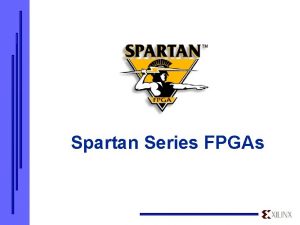Tools for synthesis and implementation using Xilinx FPGAs































































- Slides: 63

Tools for synthesis and implementation using Xilinx FPGAs

Synthesis Toolflow HDL Designer Design VHDL code Synplify Pro XST Leonardo Spectrum Synthesis Netlist ISE Project Navigator Implementation Bitstream

Synthesis stages Technology independent Compile Technology dependent Map Place & Route High level synthesis - Code analysis - Derivation of main logic constructions - Technology independent optimization - Creation of “RTL View” - Mapping of extracted logic structures to device primitives - Technology dependent optimization - Application of “synthesis constraints” -Netlist generation - Creation of “Technology View” Implement Low level synthesis - Placement of generated netlist onto the device -Choosing best interconnect structure for the placed design -Application of “physical constraints” - Bitstream generation - Burning device

Synthesis stages Technology independent Compile Technology dependent Map High level synthesis Synplify Pro Leonardo Spectrum Xilinx Synthesis Tools Place & Route Implement Low level synthesis

Why we need third-side synthesis tool? Support of larger VHDL subset More and better optimizations More stable synthesis Control and management of synthesis process more user-friendly and simpler Can be used for different technologies Possibility of working with number of revisions in parallel Advanced synthesis techniques And more …

Main Topics Lecture schedule: n Introduction to synthesis tools (Synplify and Leonardo) Environments, constraints, timing analysis, optimizations n Introduction to Place & Route tools Environments, pin assignment, timing information extraction (Advanced analysis tools for FPGAs) Using IMPACT – burning tool n Timing simulation

Introduction to synthesis Synplify Pro synthesis tool

Tool invocation Invocation of Synplify Pro performed by double click on “Synplify PRO flow” in “Team tasks” or by pressing button in toolbar Synplify Pro invocation button Synplify Pro invocation link

Tool tuning Working directory for Synplify is one defined in “Downstream” in HDL Designer For each revision new directory is created and all Synplify-generated files are placed there In case of using Core. Gen, netlist generated by Coregen placed in Synplify working directory and not in appropriate revision directory. Copy it to revision directory To avoid errors caused by embedded configurations, make them standalone by:

Synplify Pro main window Start synthesis Status line Working with files Working with revisions Window with source files Window with result files Messages, warnings and errors Watch window Main optimizatio n modes

Understanding list of source files If you use package(s), put it first in the list of files Number of revision (version) The main entity should be last in the list of files If you have also Verilog files, separate directory will be created In such case, main block of the design must be defined in another place

Compilation process Compilation is the first stage of synthesis process There is a possibility to invoke compilation only (without mapping) by choosing “Run->Compile only” or pressing F 7 After compilation Synplify main window looks like this: Show RTL view Some files were generated

Understanding report file All errors, warnings and notes reported during compilation, are written to “. srr” file This file can be viewed by double click on its name in right window or pressing “View Log” button on the left side of the main window Crossprobing makes possible viewing problematic code by simple double click on errror/warning/note message Each error message started from @E and colored to red Each warning message started from @W and colored to violet Each note message sarted from @N and colored to blue

Understanding RTL view can be opened by pressing or double click on “. srs” file The group of buttons is useful in “RTL view” window General logic structures can be recognized on RTL view comparator incrementer גדול MUX

Crossporbing between RTL view and code Each port, net or block can be chosen by mouse click from the browser or directly from the RTL View By double-clicking on the element its source code can be seen: Reverse crossprobing is also possible: if section of code is marked, appropriate element of RTL View is marked too:

Understanding FSM Viewer Synplify Pro has feature to show state machines in graphic form (like HDL Designer). The feature is invocated by indicating “V” for “FSM Compiler” option Crossprobing is possible between graphical representation of FSM and its states / transactions list Initial states Coding of states after compilation Coding of states after mapping

Mapping process Compilation of design is not enough – to complete high level synthesis we need to perform also mapping Mapping is technology dependent stage of synthesis During mapping, excluding mapping itself, are performed the next processes: Application of “synthesis constraints” Generation of netlist Initial timing analysis Generation of “Technology View” Synthesis constraints HDL source files Compilation RTL view Compiled (RTL) netlist Mapping Technology view Mapped netlist (edif) To place & route Post map timing analysis

Defining device parameters All mapping parameters defined via “implementation options” window The window is opened by pressing button or by double-click on current revision The first step is choosing device for implementation Device-specific mapping options can apply different optimizations Stand on specific option and press F 1 to learn more about it

Defining compilation optimizations Compilation optimizations can be defined in “Options” tab The same optimizations can be invoked from the main Synplify window

Defining constraint files to be applied Global frequency and constraint files can be defined in the next tab “Constraints” (we will see constraint files later)

Defining result files Location of result files created after mapping process can be defined in the tab “Implementation results” Additional files can be created: Post-map netlist in HDL format for post-map timing simulation Physical constraints file for P&R tools Important note: to prevent problems with lowlevel sythesis tools, the name of result netlist (edif file) should be similar to the name of the top design entity Post map netlist in HDL format P&R constraint file

Timing report definitions Timing report form can be configured by specifying number of reported critical paths or/and start/end points

Synthesis constraints specification - SCOPE (Synthesis Constraint Optimization Environment) is graphical tool for defining different (mainly timing) constraints The output of SCOPE is the synthesis constraint file (“. sdc”) which is attached to RTL netlist and applied during mapping stage SCOPE is invoked by pressing button or by specifying File->New>Constaint File Main window of SCOPE divided to tabs by constraint types

Types of synthesis constraints The groups of constraints are: Clocks – defining design clocks’ form and frequency, groups of clocks, there is possibility to define part of period intended to routing delay Clock to clock – defining relations between clocks Input / output delays – defining propagation delays of input (Input port -> FF) or output (FF -> Output port) paths Registers – defining setup times and propagation delays of FFs Paths constraints Multi-cycle – paths between FFs in which signal is allowed to be propagated in more than one clock False – paths which is not required to be analyzed Max-delay – paths constrained to certain delay value Attributes – additional (non-timing) constraints Black box definitions Object pruning prevention Excluding code for synthesis And more …

Mapping invocation Mapping (including compilation) is invocated by pressing F 8 , choosing “Run->Synthesize” or by pressing Showing Technology View Number of files were created Errors and warnings can appear

Understanding of Technology View Technology view is mapped RTL view. It can be seen by pressing button or by double-click on “. srm” file As in case of “RTL View”, buttons can be used here Two additional buttons are enabled: Pay attention: technology view is usually large and presented on number of sheets Ports, nets and blocks browser - show critical path - open timing analyst Technology view is presented using device primitives

Viewing critical path Critical path can be viewed by pressing on Slack and delay values are written near each component of the path

Timing Analyst Timing analyst opened by pressing on Timing analyst gives a possibility to analyze different paths in the design Timing analyst can be opened only from Technology View

Timing report is part of general report file “. srr” Do search of “START OF TIMING REPORT” in “. srr” file to get it Next things can be found in this report: General design information – name, included constraint files, required frequency, required number of critical paths to be reported Performance summary – achieved frequency, worst slack Clock relationship – table with rise to rise, rise to fall, fall to rise and fall to fall delays for each pair of clock groups Interface information – standing in requirements for input / output delays Detailed report for each clock group of the design, including: Table with all most critical path for this clock group Table with all start / end points for critical paths for this clock group Separate table of signal propagation for each critical path

Working with number of revisions Synplify gives a possibility to create number of revisions of the design, to synthesize them and compare. The most used options are: Creation of new revision of the same design with the same constraints but for another technology Creation of new revision of the same design with different constraints for another technology New revision can be created by pressing on or by choosing “Project -> New Implementation” New revision automatically accepts new revision number Current revision is marked by green arrow All revisions can be synthesized by choosing “Run->Run All Implementations”

Introduction to synthesis Leonardo Spectrum synthesis tool briefly

Tool invocation Invocation of Leonardo Spectrum performed by double click on “Leonardo Spectrum flow” in “Team tasks” or by pressing button in toolbar Leonardo Spectrum invocation button Leonardo Spectrum invocation link

Tool invocation The window for “fast start” is opened after invocation:

Leonardo definitions There are two types of menus: n n Quick setup – perform synthesis defining minimal set of options Advanced flow tab – this tab includes options to define constraints, form of reports and invocation of P&R tools Switching between two menus perfomed by:

Quick setup window There is quick setup window:

Advanced flow tab facilitates synthesis in steps: In addition there is also “Synthesis Wizard”, which passes via all above tabs one-by-one

Analysis of synthesis results

Adding constraints

High-level synthesis – conclusions To obtain good synthesis results, always follow the next rules: Write understandable HDL code. Think hardware, not software! Analyze report file after compilation and after mapping: - did you mean to make RAM here? - does this register really redundant? - why black box is created? Especially pay attention to recognized clocks and generated latches Use FSM Compiler to analyze derived FSM and compare them to ones drawn in HDL designer Analyze inserted buffers in Technology View Apply optimizations carefully Use synthesis constraints to tune the design and estimate timing Follow file naming conventions to avoid problems in low-level synthesis tools

Introduction to place and route tools Xilinx Project Navigator P&R tool

Reminder - synthesis stages Technology independent WE ARE HERE Compile Map Technology dependent Place & Route High level synthesis - Code analysis - Derivation of main logic constructions - Technology independent optimization - Creation of “RTL View” - Mapping of extracted logic structures to device primitives - Technology dependent optimization - Application of “synthesis constraints” -Netlist generation - Creation of “Technology View” Implement Low level synthesis - Placement of generated netlist onto the device -Choosing best interconnect structure for the placed design -Application of “physical constraints” - Bitstream generation - Burning device

Tool invocation From Synplify: From Leonardo:

But, there is a problem… When running from Synplify: n ISE project is created, but Project Navigator is not opened… When running from Leonardo: n Project Navigator is opened, but project is not created… So, if you use Synplify: Try to run Project Navigator (it will create the project), and after that invoke tool from Windows If you use Leonardo: Open Directly Project Navigator from the Windows

Project Navigator main window Source files Results window Synthesis processes Log window – errors, warnings and notes

Creation of new project If you work with Leonardo, you have to create new project firstly New Project is created by “File->New Project” Project directory not necessary have to be output directory of high -level synthesis tool EDIF must be chosen as top-level module type After choosing press next

Creation of new project EDIF file created after high-level synthesis should be entered as input design All netlists created by external tools (such as Core. Gen) should be placed in the project directory together with main netlist If you want your netlist will not be affected by high-level resynthesis, specify “copy input design to the project directory” (relevant if your project directory differs from output directory of high-level synthesis tool) We will discuss further the constraint file Press next

Creation of new project Verify that you use right device and “Modelsim “ simulator Press “Next” and then “Finish”

Opening existing project Open existing project (when working with Synplify) by: “File -> Open Project…” … and further choosing “. npl” file

Understanding project view After creation or opening, design file(s) (netlist) displayed in the left top window Possible processes displayed in the left bottom window Process can be invoked by doubleclicking on its name When you invoke the process, the tool performs check and invokes previous processes if needed But: Before place & route starts, we have to define physical constraints file

Physical constraints file Reminder – toolflow: Synthesis constraints Compiled (RTL) netlist Mapping Technology view Physical constraints Mapped netlist (edif) Post map timing analysis Place & route Routed design view Placed and routed netlist (ncd) Bitstream (bit) Post P&R timing analysis Physical constraints file (“. ucf”) must me provided to perform Place & Route in the right way This file is necessary for pin assignment, because it attaches physical device pins to design external ports (in contrast with synthesis constraints file that is not necessary to produce right implementation)

Physical constraints file Creation of new constraints file: Choose design file constraints file attached to… Choose name… New constraints file is added under defined design file

Physical constraints file Constraint file can be edit by several ways: n Using special programs for constraints n Or by editing constraints file directly The latter way is preferred (more simple) You can use reference constraints file and just to change pin assignments relevant for your design (can be found at Q: Virtex II PROconstraints file) Constraint file has very simple structure and looks like this: “NET” + name of the port in the design “LOC” + name of the FPGA pin Names of pins can be found at: Q: Virtex II Prodevelopment boarduser_guide

Extraction of timing information Reminder – toolflow: HDL source files Physical constraints Mapped netlist (edif) Place & route Post P&R timing analysis Placed and routed netlist (ncd) Bitstream (bit) Post P&R timing simulation model Timing simulation is required to check if the design works right with real delay values (post Place & Route timing simulation model) Non standing of design in real timing can cause changing of HDL source files Information for timing simulation is extracted from Project Navigator

Extraction of timing information To accept files for timing simulation: Choose “Modelsim VHDL” for “Simulation Mode target” Choose right device speed Press OK and double click on “Generate post Place & Route Simulation Model” to invoke Two files are created : “design name”_timesim. vhd – VHDL description of netlist “design name”_timesim. sdf – file with timing information

Burning device - IMPACT Double-click on “Generate programming file” to generate bitstream for downloading (“. bit” file) The tool will invoke all required previous processes Burning of FPGA is executed by IMPACT tool

Burning device - IMPACT When starting, IMPACT will display wizard which will guide you through the programming process Attention: download cable should be connected and board power on before running IMPACT ! If there are no problems with JTAG, 3 devices are recognized on the board: First two devices are on-board PROMS, we are not interested in them (press Cancel twice) Virtex II PRO is the third in the JTAG chain of the board

Burning device - IMPACT Right click on Virtex II PRO and select “Assign new configuration file” Select required “. bit” file and press “Open” Right click on Virtex II PRO and select “Program” Press “OK” – device will start programming:

Timing Simulation

Placing timing simulation files into HDL designer During P&R we have accepted two files: n “. vhd” – containts HDL description of netlist n “. sdf” – containts timing information These files will be used in HDL Designer for timing simulation Firstly, add HDL netlist, as External IP: This block will replace the old one in test bench architecture

Placing timing simulation files into HDL designer Now, start Modelsim by When start window opens, add command for loading “. sdf” file -sdftyp /<path_to_instance> = <path_to_sdf_file> <path_to_instance> is hierarchical path to instance of HDL netlist, where hierarchical levels separeted by “/” <path_to_sdf_file> file is Windows path to “. sdf” file, where “/” is used (instead of conventional “”)

Advanced analysis tools Floorplaner There are several tools giving a possibility to analyze design deeper Floorplaner – displays placed design You can check where each block of the design was placed Placing can be changed by specifying appropriate physical constraints

Advanced analysis tools – FPGA Editor displays placed and routed design Implementation of each cell can be viewed

Advanced analysis tools – Power Estimator Power estimator calculates power consumed by the design, activity factors and average current values
 Xilinx synthesis tool
Xilinx synthesis tool Embedded microprocessor system design using fpgas
Embedded microprocessor system design using fpgas 7 series fpgas clocking resources user guide
7 series fpgas clocking resources user guide Basic fpga architecture
Basic fpga architecture Xilinx university program
Xilinx university program Xilinx fpga architecture
Xilinx fpga architecture Xilinx fpga roadmap
Xilinx fpga roadmap Vhdl xilinx
Vhdl xilinx Xilinx gtp
Xilinx gtp Spartan 6 power estimator
Spartan 6 power estimator Vivado core generator
Vivado core generator Altera vs xilinx
Altera vs xilinx Xilinx soc
Xilinx soc Getting started with xilinx fpga
Getting started with xilinx fpga Xilinx
Xilinx Xilinx fpga editor
Xilinx fpga editor Xilinx lca
Xilinx lca Tables 11 to 25
Tables 11 to 25 Core solutions group
Core solutions group Xilinx concat
Xilinx concat Paul hartke
Paul hartke Total isp solution
Total isp solution Xilinx clock divider
Xilinx clock divider Pannon egyetem műszaki informatikai kar
Pannon egyetem műszaki informatikai kar Fpga presentation
Fpga presentation Implementation support in hci
Implementation support in hci The designer express the ideas in terms related to the
The designer express the ideas in terms related to the Simple calculator using lex and yacc
Simple calculator using lex and yacc Kontinuitetshantering
Kontinuitetshantering Novell typiska drag
Novell typiska drag Tack för att ni lyssnade bild
Tack för att ni lyssnade bild Returpilarna
Returpilarna Varför kallas perioden 1918-1939 för mellankrigstiden?
Varför kallas perioden 1918-1939 för mellankrigstiden? En lathund för arbete med kontinuitetshantering
En lathund för arbete med kontinuitetshantering Underlag för särskild löneskatt på pensionskostnader
Underlag för särskild löneskatt på pensionskostnader Vilotidsbok
Vilotidsbok A gastrica
A gastrica Vad är densitet
Vad är densitet Datorkunskap för nybörjare
Datorkunskap för nybörjare Tack för att ni lyssnade bild
Tack för att ni lyssnade bild Att skriva debattartikel
Att skriva debattartikel Delegerande ledarskap
Delegerande ledarskap Nyckelkompetenser för livslångt lärande
Nyckelkompetenser för livslångt lärande Påbyggnader för flakfordon
Påbyggnader för flakfordon Kraft per area
Kraft per area Svenskt ramverk för digital samverkan
Svenskt ramverk för digital samverkan Kyssande vind analys
Kyssande vind analys Presentera för publik crossboss
Presentera för publik crossboss Teckenspråk minoritetsspråk argument
Teckenspråk minoritetsspråk argument Plats för toran ark
Plats för toran ark Treserva lathund
Treserva lathund Fimbrietratt
Fimbrietratt Bästa kameran för astrofoto
Bästa kameran för astrofoto Centrum för kunskap och säkerhet
Centrum för kunskap och säkerhet Lågenergihus nyproduktion
Lågenergihus nyproduktion Bra mat för unga idrottare
Bra mat för unga idrottare Verktyg för automatisering av utbetalningar
Verktyg för automatisering av utbetalningar Rutin för avvikelsehantering
Rutin för avvikelsehantering Smärtskolan kunskap för livet
Smärtskolan kunskap för livet Ministerstyre för och nackdelar
Ministerstyre för och nackdelar Tack för att ni har lyssnat
Tack för att ni har lyssnat Referatmarkeringar
Referatmarkeringar Redogör för vad psykologi är
Redogör för vad psykologi är Matematisk modellering eksempel
Matematisk modellering eksempel

